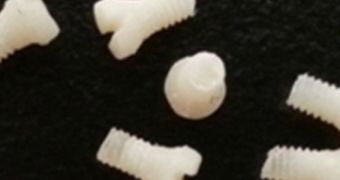An international collaboration of researchers from the Harvard Medical School, Beth Israel Deaconess Medical Center, and the School of Engineering at Tufts University announce the development of a new class of surgical devices, which are based on materials derived from silkworms.
The group adds that these compounds are far superior to metal and synthetics for producing plates, screws, and other types of devices orthopedic surgeons generally use to address bone fractures or other issues. These pieces of medical equipment are used to tie multiple bone fragments together and keep them in place until they weld together and heal.
Currently, these fixation devices are made up of metal or synthetic alloys. They need to be inserted via surgery, and removed in the same manner a few months later. The main problem however is that they can cause stress of the undamaged bones surrounding the fracture, because they are very solid and do not flex, bend, or yield in any way to pressure.
At the same time, these materials are not as biocompatible as some scientists argue. Wounds tend to take longer to heal and develop complications more often when synthetics or metal is used. The risk of infection is also relatively high. By using silkworm materials, these issues can be solved, the research group argues.
Some doctors use fixation devices made of synthetic polymers, which are reabsorbed in the body after a while. These instruments can cause inflammatory reactions in some patients and are more difficult to implant than their metal counterparts. The new approach fixes these issues as well, by using pure silk proteins extracted from silkworm cocoons.
The new generation of surgical plates and screws enables more efficient and faster bone remodeling, while also allowing for the body to reabsorb them after a while, without causing inflammation or other reactions. As such, a second surgery to remove them is no longer necessary. Details of the approach were published in the March 4 issue of the top scientific journal Nature Communications.
“Unlike metal, the composition of silk protein may be similar to bone composition. Silk materials are extremely robust. They maintain structural stability under very high temperatures and withstand other extreme conditions, and they can be readily sterilized,” says BID researcher Samuel Lin.
“Having a resorbable, long-lasting plate and screw system has potentially huge applications,” adds the expert, who holds an appointment as an associate professor of surgery with the Division of Plastic and Reconstructive Surgery at Beth Israel Deaconess. He was also a coauthor of the new study.

 14 DAY TRIAL //
14 DAY TRIAL //